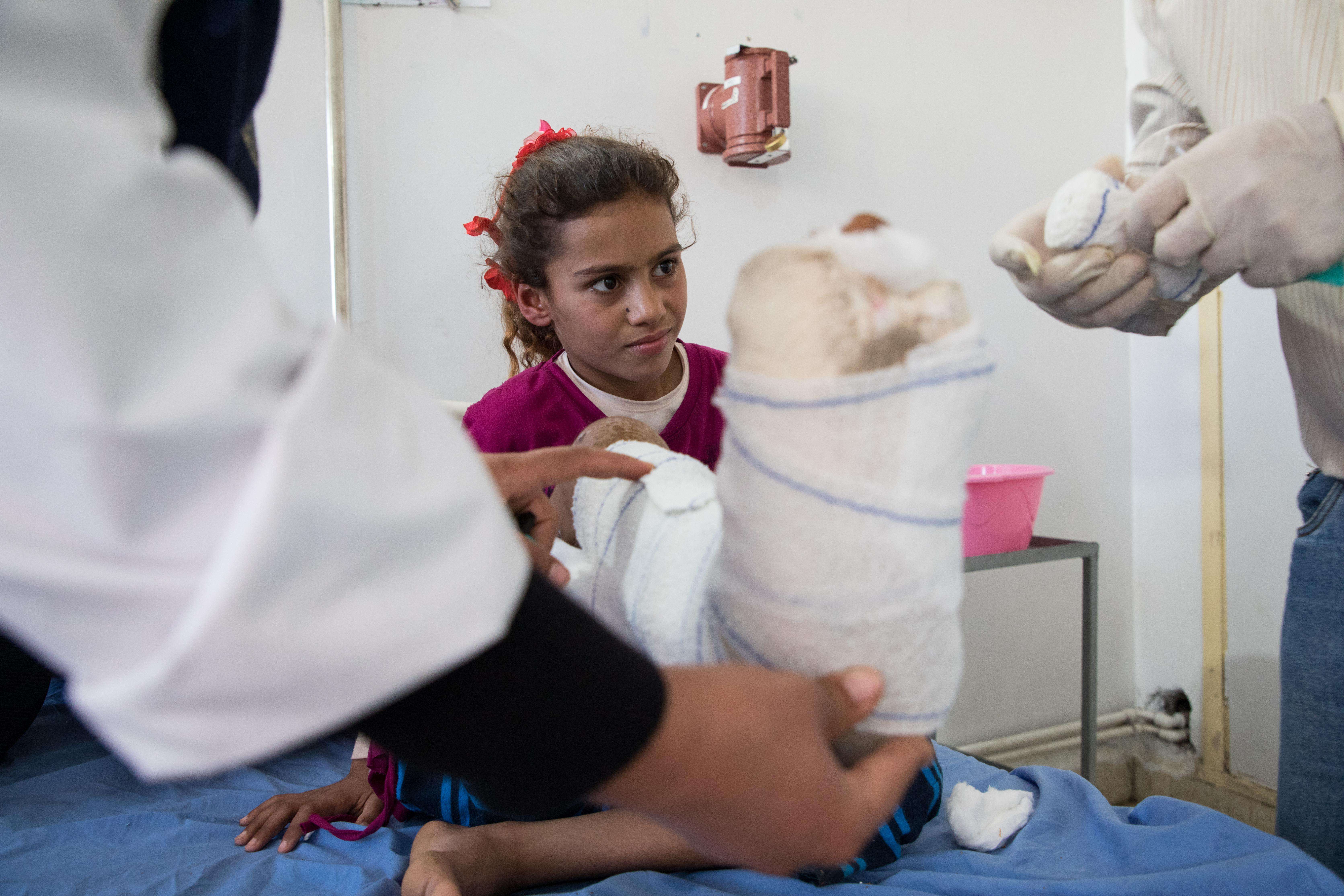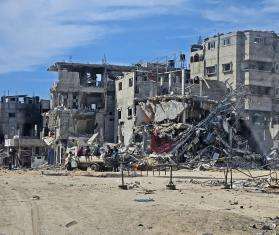GENEVA/NEW YORK, APRIL 4, 2018—The number of patients treated for injuries related to land mines and improvised explosives has doubled at an MSF-supported hospital in Hassakeh in northeast Syria in recent months, with more than half of the injuries affecting children, some as young as one, the international medical humanitarian organization Doctors Without Borders/Médecins Sans Frontières (MSF) said today.
Medical staff are seeing an increase in injured patients as people return home after fighting subsided in the Syrian governorates of Raqqa, Hassakeh, and Deir ez-Zor. Despite the clear risk to civilians from improvised explosives, and the vast medical needs in the region, the Trump Administration announced this weekend that the United States will freeze funding earmarked for recovery efforts in Syria.
"Patients tell us that land mines, booby traps, and other improvised explosive devices are planted in fields, along roads, on the roofs of houses, and under staircases," said Satoru Ida, MSF head of mission in Syria. "Household items like teapots, pillows, cooking pots, toys, air conditioning machines, and refrigerators are also reportedly rigged to explode as people return home for the first time after months or years in displacement."
MSF urgently calls on all organizations and entities involved, international and local, to expand and accelerate demining action and risk education activities, and to improve access to lifesaving medical care for victims of explosive devices in Deir ez-Zor. Moreover, MSF is concerned that the US decision to put relief and recovery funding on hold for Syria will cause an increase in civilian casualties and injuries from unexploded ordnance.
"There is a clear need for continued funding for demining efforts and for the medical care of vulnerable people in harm's way," said Jason Cone, executive director of MSF-USA. "For thousands of people returning home, this war is not over. The US and all major international actors in this conflict have a responsibility to continue to provide support to ensure that civilians can return safely and that their medical needs are met."
At the hospital supported by MSF in Hassakeh, MSF has received 133 people wounded by land mines and booby-traps in four and a half months—one per day on average. The number of patients affected by these injuries has sharply increased since late 2017, from 17 in November, to 39 in December, and 41 in January. From the beginning of February to March 14, 36 victims were treated in the hospital.
"It is a race against time," Ida said. "People are returning to what is in effect a minefield. We will see an increase in the number of blast victims without further action. Furthermore, with the health system in Deir ez-Zor paralyzed, the nearest health facility could be hours away for them. Every minute counts. If the person isn't killed on the spot, the delay in receiving medical care is in most cases what determines the severity and recovery."
In northeast Syria, MSF supports a hospital in Tal Abyad, which receives injuries mostly from Raqqa governorate, and another in Hassakeh. The latter is one of the few functioning free-of-charge, secondary health care facilities accessible to residents in Deir ez-Zor governorate.
More than 75 percent of patients admitted at the MSF-supported hospital in Hassakeh for injuries related to land mines, booby traps, and similar hazards are from Deir ez-Zor, mainly from the area of Abu Hamam, but also Hajin, Dhiban and Garanish. Some patients travel as long as six hours to reach the hospital.
Between November 2017 and March 2018, an MSF emergency clinic in Raqqa city treated approximately 427 victims of explosives, but the true figure of those affected by the contamination in the city is in reality much higher. Such is the severity of some injuries that 60 people died from their wounds on their way to the hospital or in the emergency room, and roughly 40 percent of patients have to be referred to other facilities for more intensive stabilization care or surgery.
In 2017 alone, the violence in Deir ez-Zor caused at least 254,000 people to flee. People were displaced an average of three times. This is the largest volume of population movements by governorate in Syria for the year.
While some people have returned home, the majority are still displaced and expected to travel back soon, sometimes unaware of the dangers awaiting them there. Demining experts fear that hundreds of thousands of devices still litter schools, medical facilities, and agricultural fields in Deir ez-Zor. This is based on patterns observed in other governorates and information from recent incidents.
Demining action is urgent, but risk education must also be expanded so that people can make informed decisions about returning home, learn to identify and avoid explosive devices, learn what to do immediately after a device explodes, and perform first aid in case of an accident, said MSF.
This must go hand in hand with improving access to emergency medical care—which is lifesaving in many cases—for the victims of explosive devices in Deir ez-Zor and elsewhere in northeast Syria.
"These explosive devices do not choose their targets," Ida said. "They do not respect peace treaties or ceasefires and can stay concealed for months or years after a conflict ends. If they don't kill, they destroy the lives and livelihoods of their victims and their families, trapping them in poverty by disabling their hands or legs."
Raqqa is devastated and many homes and public places were, and still are, littered with improvised explosive devices & unexploded munitions.
— Doctors w/o Borders (@MSF_USA) April 4, 2018
The Hidden Deadly Threat in photos https://t.co/ywZ3CxZ0XC




